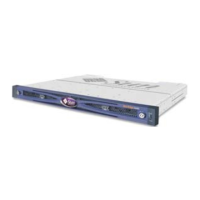Chapter 4 Connecting Your Fibre Channel Array 4-29
If you want to connect a Sun StorEdge 3510 FC array to more than four host
computers, or connect a Sun StorEdge 3511 FC array to more than six host
computers, without changing the default configuration, you can connect these four
host channels to ports on storage switches in a storage area network (SAN)
configuration.
When a fabric switch is connected to one port of channel 0 or channel 1 of a Sun
StorEdge 3511 FC array, no connections can be made with the other three ports of
that channel. If channel 0 (port FC0) is connected to a fabric switch, for example, the
second port of channel 0 on that controller, and the FC0 ports on a redundant
controller, cannot be used.
Note – The connection of a Sun StorEdge 3510 or 3511 FC array to Fibre Channel
HBAs that use different speeds (1 Gbit and 2 Gbit) on the same channel is not
supported. You can, however, mix 1-Gbit and 2-Gbit Fibre Channel HBAs on
different channels. This limitation is due to the design of Sun StorEdge Fibre
Channel array port bypass circuitry and the inability of Fibre Channel to support
auto-negotiation in a multi-drop loop configuration.
Use fiber-optic cables to connect host channels to Fibre Channel HBAs on your host
computers or to other devices such as storage switches:
1. Connect a fiber-optic cable to an HBA or FC port on each host or storage switch
you want to connect to the array.
2. Connect the SFP connector at the other end of each of these fiber-optic cables to
host channel SFP connectors on the back of the array.
If there is no SFP connector in the port you want to use, first insert an SFP connector
into the port as described in “Changing Your SFP Configuration” on page 4-18.
4.13 Power-On Sequence
Power on the equipment in the following order so the host computer discovers all
connected arrays:
a. Expansion units
b. RAID array
c. Host computers
When the array is powered on and is connected to a Solaris operating system, the
Tip connection window displays a series of messages, as shown in the following
example.

